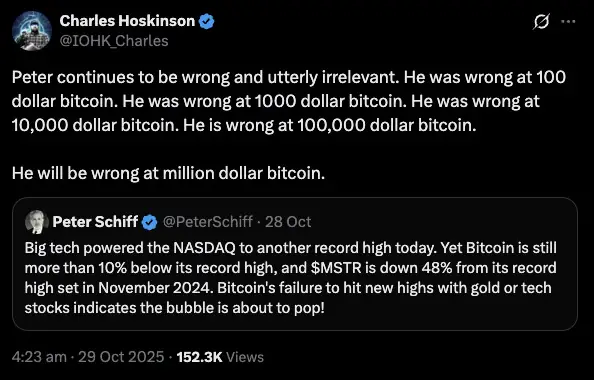Cardano Founder’s $1M Bitcoin Price Prediction Sparks Bitcoin Hyper Rally
Takeaways:
- Cardano founder Charles Hoskinson predicts $BTC will hit $1M after firing back at gold advocate Peter Schiff’s usual bearish stance.
- Bitcoin currently trades around $108K with a $2.15T market cap as traders bite back at Schiff.
- The $1M Bitcoin narrative is driving demand toward Layer 2 projects built to solve Bitcoin’s slow speed and high fees.
- Bitcoin Hyper has raised $25.6M in its presale, aiming to be Bitcoin’s missing execution layer and opening up the door to DeFi, dApps, and memes on Bitcoin with low fees and lightning-fast speed.
Charles Hoskinson, the founder of Cardano, has just called for a $1M $BTC.
Gold advocate Peter Schiff fired the first shot. He argued (as per usual) that Bitcoin is ‘a bubble about to pop’ because it has failed to keep up with the pace of gold and tech stocks. He pointed out that $BTC now trades about 10% below its all-time high, using this lag as proof that Bitcoin has run out of steam.
Hoskinson, like many, wasn’t having it. He hit back on X to point out how many times Schiff has been wrong. Ending on the fact that Schiff will be wrong at $1M $BTC.
 Source: IOHK_Charles on X
Source: IOHK_Charles on X
Well, this debate has reignited a long-running argument between gold purists and crypto believers. Hundreds of traders were in Schiff’s replies, looking to prove him wrong.
So, what’s the takeaway from all this? The $1M Bitcoin narrative is reshaping how builders and investors think about the network’s future. If Bitcoin truly becomes the world’s financial base layer, and perhaps someday overtakes gold to become the largest asset, users will want speed, scalability, and usability.
That’s where Bitcoin Hyper ($HYPER) comes in, creating the high-speed execution layer that could make a seven-figure Bitcoin actually usable.
Bitcoin’s $1M Dream Fuels Layer-2 Demand
As Bitcoin edges back to record territory, traders are starting to shift the conversation from how high it can go to how well it can work. $BTC already dominates as a store of value, but its underlying network still moves extremely slowly and is too expensive to use for everyday activities.
That’s why investors are turning to a new Layer 2 solution in Bitcoin Hyper ($HYPER), a project that aims to transform Bitcoin from a passive asset into an active ecosystem.
Bitcoin Hyper ($HYPER) – The Scalable Engine Behind Bitcoin’s $1M Future
Bitcoin Hyper is the project set to redefine what Bitcoin can do. It’s a true Layer 2 network that connects directly to the Bitcoin blockchain, but operates with the speed and flexibility of modern ecosystems.
Built on Ethereum and powered by Solana’s Virtual Machine (SVM), $HYPER lets you move, stake, and trade Bitcoin with near-zero fees and instant finality. Compare this to Bitcoin’s high costs and hour-long finality, and it’s a game-changer.
This is how it works in practice: you bridge your $BTC into Bitcoin Hyper, where it’s mirrored one-to-one on the Layer 2. From there, you can use it for lightning-fast transactions, DeFi apps, or cross-chain swaps. When you’re done, the system settles back to the Bitcoin base layer for full security and transparency.
It’s a trustless bridge, not a sidechain. This means your Bitcoin never leaves the network’s protection. Bitcoin Hyper will be the ‘execution layer’ that the $1M Bitcoin era could depend on. It’ll turn parked capital into active liquidity, unlocking the possibility of DeFi, meme coins, and new dApps all powered on Bitcoin itself.
This presale momentum indicates how much the market wants usable Bitcoin infrastructure. By pairing Bitcoin’s unmatched security with the performance of Solana’s architecture, Hyper is laying the groundwork for the next phase of crypto growth.
One where Bitcoin is given the scalability, speed, and culture it needs to become a living network.
Join the Bitcoin Hyper presale today and claim your stake in Bitcoin’s scalable future.
This publication is sponsored. Coindoo does not endorse or assume responsibility for the content, accuracy, quality, advertising, products, or any other materials on this page. Readers are encouraged to conduct their own research before engaging in any cryptocurrency-related actions. Coindoo will not be liable, directly or indirectly, for any damages or losses resulting from the use of or reliance on any content, goods, or services mentioned. Always do your own research.
The post Cardano Founder’s $1M Bitcoin Price Prediction Sparks Bitcoin Hyper Rally appeared first on Coindoo.
You May Also Like

South Korea’s $657 Million Exit from Tesla Signals a Big Crypto Pivot

Crypto execs met with US lawmakers to discuss Bitcoin reserve, market structure bills
Lawmakers in the US House of Representatives and Senate met with cryptocurrency industry leaders in three separate roundtable events this week. Members of the US Congress met with key figures in the cryptocurrency industry to discuss issues and potential laws related to the establishment of a strategic Bitcoin reserve and a market structure.On Tuesday, a group of lawmakers that included Alaska Representative Nick Begich and Ohio Senator Bernie Moreno met with Strategy co-founder Michael Saylor and others in a roundtable event regarding the BITCOIN Act, a bill to establish a strategic Bitcoin (BTC) reserve. The discussion was hosted by the advocacy organization Digital Chamber and its affiliates, the Digital Power Network and Bitcoin Treasury Council.“Legislators and the executives at yesterday’s roundtable agree, there is a need [for] a Strategic Bitcoin Reserve law to ensure its longevity for America’s financial future,” Hailey Miller, director of government affairs and public policy at Digital Power Network, told Cointelegraph. “Most attendees are looking for next steps, which may mean including the SBR within the broader policy frameworks already advancing.“Read more
